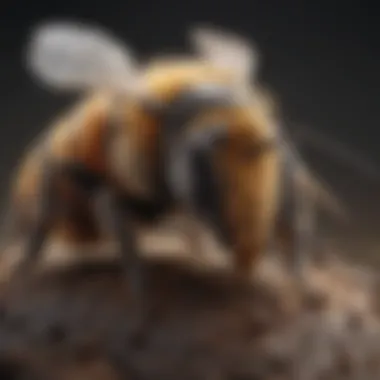Effective Strategies for Removing Africanized Bees Safely


Preventive Pest Control Strategies
When it comes to safeguarding your home against the threat of Africanized bees and other pests, implementing preventive pest control strategies is paramount. One of the key areas to focus on is protecting the exterior of your house. This includes sealing cracks around windows and doors, as well as clearing debris that could serve as a nesting ground for pests. By taking these simple steps, you can greatly reduce the likelihood of pests entering your home.
Yard maintenance plays a crucial role in keeping your property pest-free. Regularly mowing the lawn, trimming bushes, and removing standing water can help deter pests from settling in your yard. Additionally, creating a barrier of gravel or mulch between your yard and the exterior walls of your home can act as a deterrent for pests.
Maintaining cleanliness indoors is also key to pest prevention. By regularly vacuuming, dusting, and storing food in airtight containers, you can eliminate potential attractions for pests. Proper garbage disposal is another essential aspect of pest control. Ensuring that garbage bins are tightly sealed and emptied regularly can help prevent pests from being drawn to your property.
In addition to these primary strategies, there are numerous other innovative ways to safeguard your home from pests. These can include using natural repellents, installing screening on doors and windows, and implementing integrated pest management practices to address pest issues holistically.
Understanding Africanized Bees
This article is crucial as it aims to provide an in-depth insight into the intricate world of Africanized bees. Understanding Africanized bees is fundamental for anyone dealing with these unique creatures, particularly concerning safety, effective removal strategies, and preventive measures. By delving into their characteristics, habitat, and nesting behavior, readers can equip themselves with the knowledge needed to address infestations successfully. Additionally, comprehending the behavior of Africanized bees can aid in identifying potential threats and implementing appropriate measures to mitigate risks.
Characteristics of Africanized Bees
Aggressiveness
Aggressiveness is a pivotal characteristic of Africanized bees that significantly impacts their behavior and interaction with their surroundings. Known for their heightened defensive instincts, Africanized bees exhibit a swift and robust response to perceived threats, making them more likely to attack in larger numbers compared to other bee species. This aggressiveness stems from their genetic composition, as they have inherited traits that prioritize colony protection above all else. While this trait enhances their ability to defend against predators and other dangers, it also poses a greater risk to humans and animals in proximity to their hives. Understanding the aggressiveness of Africanized bees is paramount in developing comprehensive removal strategies that prioritize safety and efficiency.
Swarming Behavior


Swarming behavior is another defining trait of Africanized bees, contributing to their reputation for rapid hive establishment and expansion. Africanized bees tend to swarm more frequently and in larger groups than their European honeybee counterparts, enabling them to establish new colonies swiftly. This behavior poses challenges in bee removal efforts, as swarms can relocate and form nests in diverse environments, including residential areas. The unique feature of prolific swarming in Africanized bees amplifies the need for proactive measures to prevent infestations and ensure the safe removal of established colonies.
Physical Appearance
The physical appearance of Africanized bees presents distinct features that set them apart from other bee species. Compared to European honeybees, Africanized bees exhibit subtle variations in size, coloration, and wing morphology. Their physical characteristics play a vital role in their adaptation to various environments and foraging behaviors. Recognizing these differences is crucial in accurately identifying Africanized bees during infestation assessments and removal procedures. While their physical appearance may share resemblances with other bee species, specific attributes unique to Africanized bees serve as key identifiers for effective pest management strategies.
Assessing the Infestation
Identifying Africanized Bees
Visual Identification
Visual identification is a fundamental aspect in distinguishing Africanized bees from other bee species. The primary characteristic to look for in visually identifying Africanized bees is their physical appearance, which includes a darker coloration and distinct anatomical features compared to European honey bees. The key advantage of visual identification lies in its simplicity and applicability for amateur beekeepers or concerned homeowners. By recognizing the unique traits of Africanized bees visually, individuals can take timely action to address the infestation before it escalates. However, a potential disadvantage of visual identification is the need for keen observation skills and the possibility of misidentifying bees due to similarities in appearance.
Behavioral Cues
Behavioral cues offer valuable insights into identifying Africanized bees based on their actions and interactions. Specific behaviors exhibited by Africanized bees, such as increased aggression, frequent swarming, and defensive responses to disturbances, can serve as defining characteristics for differentiation. The key benefit of relying on behavioral cues is the dynamic nature of bee reactions, providing real-time indications of the bee's aggressiveness and presence. By understanding the behavioral patterns of Africanized bees, individuals can exercise caution and take suitable measures to protect themselves while assessing the infestation. Nevertheless, interpreting behavioral cues accurately demands close observation and knowledge of bee behavior to avoid potential risks posed by misinterpretation.
Safety Precautions
Protective Gear
The use of protective gear is an essential component of ensuring the safety of individuals involved in the removal or extermination of Africanized bees. Protective gear includes specialized clothing, gloves, veils, and beekeeping suits designed to shield against bee stings and minimize exposure to potential risks during removal procedures. The key characteristic of protective gear lies in its ability to provide a physical barrier between beekeepers and bees, reducing the chances of stings and allergic reactions. Opting for appropriate protective gear recommended for handling Africanized bees can significantly enhance safety measures and mitigate potential hazards encountered during removal tasks. However, the disadvantage of protective gear lies in the discomfort or restriction it may impose on individuals due to the bulkiness or heat retention associated with prolonged use.


Professional Assistance
Seeking professional assistance from experienced bee removal specialists or pest control services is a prudent choice when dealing with Africanized bee infestations. The key advantage of professional assistance is the expertise and efficiency offered by trained professionals equipped with the necessary tools and knowledge to tackle bee removal effectively. By engaging professionals, homeowners can ensure a systematic approach to assessing the infestation, implementing removal strategies, and safeguarding their property against recurring bee presence. Additionally, professional assistance minimizes the risks of injuries, mitigates potential property damage, and provides peace of mind through the assurance of a thorough and safe removal process. However, the drawback of relying on professional assistance lies in the associated costs and reliance on external services, which may not be feasible for all homeowners depending on their budget or preferences.
Effective Removal Strategies
In the realm of pest control, effective removal strategies play a vital role in dealing with Africanized bees. These strategies are essential for ensuring a safe and successful bee removal process. The careful selection of removal methods can significantly impact the outcome of bee removal operations. By employing appropriate strategies, homeowners can safeguard their properties and families from the threats posed by Africanized bees.
Non-Lethal Removal Methods
Hive Relocation
Hive relocation is a pivotal aspect of non-lethal removal methods when dealing with Africanized bees. This process involves physically relocating the bee colony to a more suitable location away from residential areas. The key characteristic of hive relocation lies in its humane approach to bee removal, aiming to preserve the bees rather than exterminate them. This method is popular among environmentally-conscious individuals and those who value the importance of bees in the ecosystem. One unique feature of hive relocation is its sustainable nature, as it allows for the bees to continue their vital role as pollinators in a more suitable environment. While hive relocation is a commendable choice for bee conservation, it may pose challenges in terms of finding appropriate relocation sites and necessitates expertise in handling bee colonies.
Bee Repellents
Bee repellents serve as another non-lethal removal method to dissuade Africanized bees from nesting on residential properties. These repellents are designed to deter bees without causing harm to the insects. The key characteristic of bee repellents is their ability to create a deterrent barrier that discourages bees from establishing nests in unwanted areas. This method is a popular choice for individuals seeking a non-invasive approach to bee control. One unique feature of bee repellents is their versatility, as they can be applied in various forms such as sprays or natural deterrents. While bee repellents offer a humane way to manage bee populations, their effectiveness may vary depending on factors such as bee species and environmental conditions.
Lethal Removal Techniques
Insecticides


Insecticides play a crucial role in lethal removal techniques for eradicating Africanized bees. These chemical substances are formulated to eliminate bee colonies by targeting the insects directly. The key characteristic of insecticides lies in their rapid effect on bee populations, providing a quick solution to bee infestations. This method is a popular choice for situations where non-lethal methods prove ineffective or when bees pose a significant threat to human safety. One unique feature of insecticides is their efficiency in eradicating bee colonies swiftly, reducing the risk of bee stings and property damage. However, the use of insecticides raises concerns regarding environmental impact and potential harm to beneficial insect species.
Fumigation
Fumigation stands out as a lethal removal technique that involves the use of fumigants to eliminate Africanized bee colonies. This method entails sealing off the infested area and introducing fumigants that disperse throughout the space, exterminating bees within the treated area. The key characteristic of fumigation is its comprehensive approach to bee removal, ensuring thorough eradication of bee populations within confined spaces. Fumigation is a beneficial choice for handling large-scale bee infestations in structures or enclosed spaces. One unique feature of fumigation is its ability to reach hidden or inaccessible bee nests, rendering it effective in scenarios where traditional removal methods fall short. However, the use of fumigants requires careful adherence to safety protocols to protect residents and the environment from potential hazards.
Post-Removal Measures
In the realm of dealing with Africanized bees, post-removal measures are crucial to ensuring a complete and safe elimination process. They go beyond the physical removal of bees to eradicate any remnants of their presence and prevent future infestations. A comprehensive approach to post-removal measures can safeguard your property and provide peace of mind.
Cleaning and Sanitizing
Removing traces of bee presence:
Removing traces of bee presence involves meticulous inspection and cleaning of areas where bees resided. This step is vital as it eliminates pheromones that may attract more bees in the future. By effectively erasing these traces, you minimize the likelihood of a re-infestation, ensuring a thorough removal process. The meticulous removal of all remnants is key to preventing a recurrence of bee activity.
Sanitizing affected areas:
On the other hand, sanitizing affected areas involves disinfection and decontamination to remove any lingering pathogens or debris left behind by the bees. This step not only ensures the health and safety of your household but also helps in maintaining a hygienic environment post-removal. Through proper sanitization, you neutralize any potential threats that these bees may have introduced, promoting a clean and habitable space.
Preventive Measures
Sealing entry points:
Sealing entry points is a fundamental step in preventing bee re-entry and securing your property against future infestations. By identifying and sealing off potential entryways used by bees, you create a barrier that deters their return. This proactive measure not only protects your home but also disrupts the bees' access, minimizing the chance of a repeated incursion.
Regular inspections:
Regular inspections play a vital role in maintaining a bee-free environment. By conducting routine checks of your property, you can identify early signs of bee activity or potential entry points. These inspections enable timely intervention, allowing you to address any vulnerabilities before they escalate into a full-on infestation. Consistent monitoring is key to sustaining a bee-free space and ensuring the effectiveness of your removal efforts.



